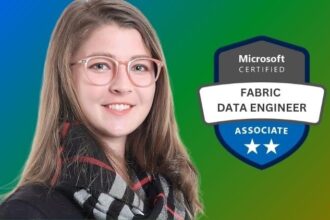What
You’ll Learn
You’ll Learn
- Decoupled Services: Understanding how to break down a monolithic application into smaller
- independent services that communicate with each other.
- Scalability: Learning how microservices allow for scaling individual components of an application independently
- leading to more efficient resource usage.
- Resilience: Implementing techniques such as circuit breakers
- retries
- and fallbacks to ensure that microservices can handle failures gracefully.
- Independent Deployment: Gaining the ability to deploy
- update
- and roll back individual services without affecting the entire application.
- Domain-Driven Design (DDD): Applying DDD principles to define microservices around business capabilities
- ensuring each service has a clear and bounded context.
- API Management: Understanding the importance of designing well-defined APIs for communication between microservices
- often using RESTful services or gRPC.
- Service Discovery: Learning how services can find and communicate with each other dynamically using service discovery tools like Consul or Eureka.
- Data Management: Handling distributed data management
- including the challenges of data consistency
- synchronization
- and transactions across multiple services.
- Containerization: Using containers (e.g.
- Docker) to package and deploy microservices
- ensuring consistency across different environments.
- Orchestration: Managing the deployment
- scaling
- and operation of containerized microservices using orchestration tools like Kubernetes.
- Event-Driven Architecture: Leveraging event-driven architecture to enable asynchronous communication between microservices
- enhancing decoupling and responsiven
- Security: Implementing security best practices for microservices
- such as authentication
- authorization
- and secure communication between services.
- Monitoring and Logging: Setting up centralized monitoring and logging to track the health and performance of microservices
- and diagnose issues quickly.
- Fault Isolation: Understanding how microservices architecture isolates faults to prevent a failure in one service from bringing down the entire system.
- Continuous Integration/Continuous Deployment (CI/CD): Implementing CI/CD pipelines to automate the testing and deployment of microservices
- enabling faster and
- API Gateway: Using an API Gateway to manage and route requests to various microservices
- providing a single entry point to the system.
- Inter-Service Communication: Understanding various communication methods between microservices
- such as synchronous (HTTP/REST) and asynchronous (messaging queu
- Circuit Breaker Pattern: Implementing the circuit breaker pattern to protect microservices from cascading failures during high load or failures.
- DevOps Collaboration: Working closely with DevOps to manage the operational aspects of microservices
- including deployment
- scaling
- and monitoring.
- Unleashing Flexibility: Mastering the Decorator Pattern
- Ensuring Reliable Commitments: Cracking the 2PC Pattern
- Orchestrating Resilient Workflows: The Saga Pattern in Action
Requirements
- No Programming Experience? No Problem! Start Your Journey Today
Description
Microservices Mastery: From Learner to Innovator
Unlock the full potential of microservices architecture with our detailed course on ASP.NET Core. Whether you’re looking to enhance your skills or start from scratch, this course has you covered!
What You’ll Learn:
-
-
Decoupled Services: Understanding how to break down a monolithic application into smaller, independent services that communicate with each other.
-
Scalability: Learning how microservices allow for scaling individual components of an application independently, leading to more efficient resource usage.
-
Resilience: Implementing techniques such as circuit breakers, retries, and fallbacks to ensure that microservices can handle failures gracefully.
-
Independent Deployment: Gaining the ability to deploy, update, and roll back individual services without affecting the entire application.
-
Domain-Driven Design (DDD): Applying DDD principles to define microservices around business capabilities, ensuring each service has a clear and bounded context.
-
API Management: Understanding the importance of designing well-defined APIs for communication between microservices, often using RESTful services or gRPC.
-
Service Discovery: Learning how services can find and communicate with each other dynamically using service discovery tools like Consul or Eureka.
-
Data Management: Handling distributed data management, including the challenges of data consistency, synchronization, and transactions across multiple services.
-
Containerization: Using containers (e.g., Docker) to package and deploy microservices, ensuring consistency across different environments.
-
Orchestration: Managing the deployment, scaling, and operation of containerized microservices using orchestration tools like Kubernetes.
-
Event-Driven Architecture: Leveraging event-driven architecture to enable asynchronous communication between microservices, enhancing decoupling and responsiveness.
-
Security: Implementing security best practices for microservices, such as authentication, authorization, and secure communication between services.
-
Monitoring and Logging: Setting up centralized monitoring and logging to track the health and performance of microservices, and diagnose issues quickly.
-
Fault Isolation: Understanding how microservices architecture isolates faults to prevent a failure in one service from bringing down the entire system.
-
Continuous Integration/Continuous Deployment (CI/CD): Implementing CI/CD pipelines to automate the testing and deployment of microservices, enabling faster and more reliable releases.
-
API Gateway: Using an API Gateway to manage and route requests to various microservices, providing a single entry point to the system.
-
Versioning: Handling versioning of APIs and services to ensure backward compatibility as the system evolves.
-
Inter-Service Communication: Understanding various communication methods between microservices, such as synchronous (HTTP/REST) and asynchronous (messaging queues).
-
Circuit Breaker Pattern: Implementing the circuit breaker pattern to protect microservices from cascading failures during high load or failures.
-
DevOps Collaboration: Working closely with DevOps to manage the operational aspects of microservices, including deployment, scaling, and monitoring.
-
Join now and take the first step towards becoming a microservices architect!
Who this course is for:
- Web Development Enthusiasts
- Curious Learners
- Aspiring Developers
- Creative Minds
- Continuous Improvers






